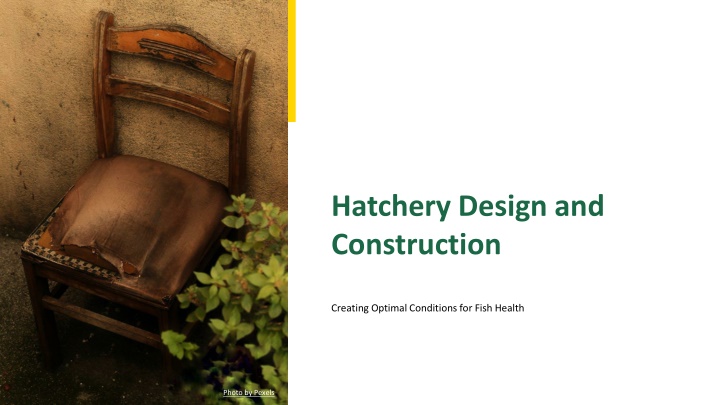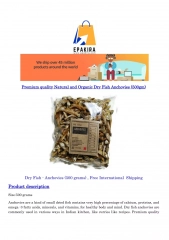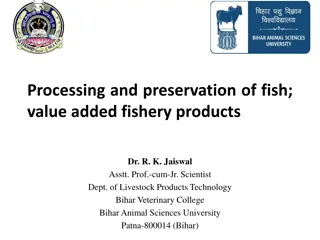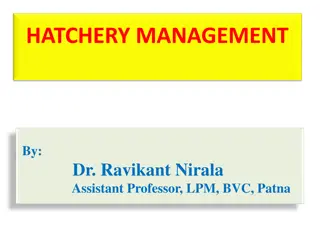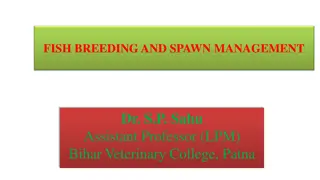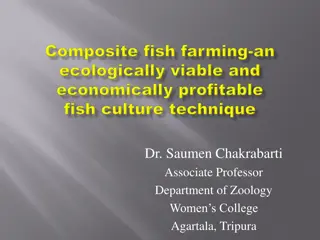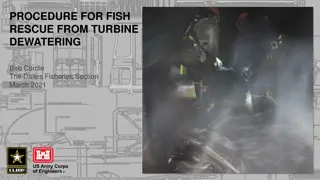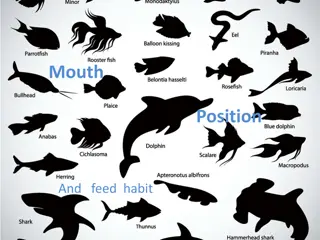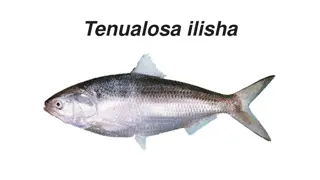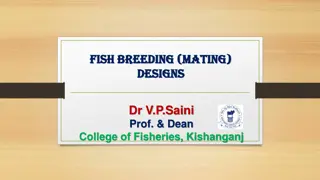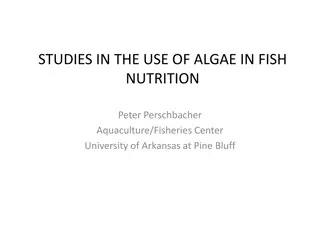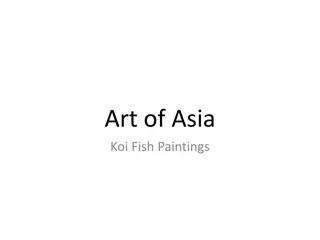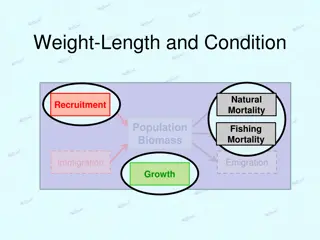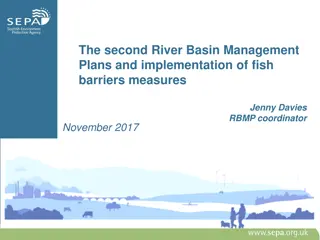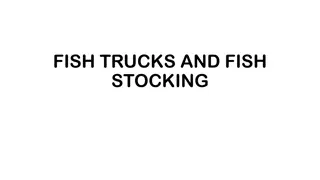Creating Optimal Conditions for Fish Health at Hatchery
Prioritizing high-quality water sources, implementing effective water treatment systems, establishing robust pathogen control measures, and maintaining a quality environment are crucial steps in ensuring the health and success of fish production at a hatchery. Careful site selection, thoughtful design layout, and strategic planning play key roles in creating optimal conditions for fish welfare and maximizing productivity. Stay ahead with monitoring systems and adapt to evolving practices for sustainable hatchery operations.
Download Presentation

Please find below an Image/Link to download the presentation.
The content on the website is provided AS IS for your information and personal use only. It may not be sold, licensed, or shared on other websites without obtaining consent from the author.If you encounter any issues during the download, it is possible that the publisher has removed the file from their server.
You are allowed to download the files provided on this website for personal or commercial use, subject to the condition that they are used lawfully. All files are the property of their respective owners.
The content on the website is provided AS IS for your information and personal use only. It may not be sold, licensed, or shared on other websites without obtaining consent from the author.
E N D
Presentation Transcript
Hatchery Design and Construction Creating Optimal Conditions for Fish Health Photo by Pexels
01 Site Selection: The Foundation Table of Contents 02 Water Treatment: Essential Practices 03 Pathogen Control: Safeguarding Fish 04 Quality Environment: Stress Reduction 05 Toxic Gas Management: Safety First 06 Water Quality: The Backbone 07 Design Layout: Strategic Planning 08 Monitoring Systems: Stay Ahead 09 Future Trends: Evolving Practices 10 Thank You!
1 Site Selection: The Foundation Choose Wisely Selecting a hatchery site requires prioritizing high-quality water sources that are free of pathogens and fish. This ensures optimal health. An ideal water source offers a potential for being specific pathogen-free, preventing disease spread among fish populations in the hatchery. The selection process must balance quality and quantity, emphasizing that sacrificing quality may jeopardize fish health and hatchery success. Ultimately, careful site selection is crucial for the enduring success of the hatchery and the fish it produces. Photo by Pexels
2 Water Treatment: Essential Practices Purifying the Source Implementing effective water treatment systems is vital for improving overall water quality and minimizing pathogens in the hatchery. Pre-treatment methods may include oxygenation, degassing, and iron removal, ensuring water meets required standards for fish health. Importantly, economic factors also influence equipment selection, necessitating a balance between cost and water quality improvement. Through diligent water treatment, hatcheries can lay a strong foundation for healthy fish production and thriving aquatic Photo by Pexels systems.
3 Pathogen Control: Safeguarding Fish Prevention is Key Establishing robust sanitation protocols and disinfection processes is paramount in controlling pathogens within the hatchery environment. Zoning operational areas effectively helps contain infectious agents, minimizing the risk of disease spread among fish stocks. Quarantine measures are also essential, especially for fish sourced externally, to prevent introducing potential pathogens into the hatchery. Human factors play a vital role; education and training are crucial for successful pathogen control and fish health Photo by Pexels management.
4 Quality Environment: Stress Reduction Optimal Conditions Matter Creating a quality environment is critical, focusing on water quality management to minimize stress levels in fish during rearing. Maintaining stable temperatures and optimal oxygen levels directly influences fish health and productivity in hatchery settings. Poor water quality can lower production potential; hence, quality setups are needed to foster healthy growth and development. Design considerations should prioritize environments that facilitate optimal fish welfare and maximized production Photo by Pexels outcomes.
5 Toxic Gas Management: Safety First Controlling Risks A core design principle is to control and eliminate toxic gases, such as hydrogen sulfide, to ensure a safe fish-hatching environment. Utilizing degassing devices effectively removes harmful gases, preventing potential adverse effects on fish during their critical growth stages. Maintaining nitrogen levels at or below 100% saturation is vital to avoid toxicity, ensuring a safe habitat for fish populations. By managing toxic gas emissions, hatcheries can create healthier production settings for their aquatic life. Photo by Pexels
6 Water Quality: The Backbone High Standards Required Water quality is fundamentally linked to hatchery design, as it directly influences fish health and overall production success. The higher the water quality, the greater the production potential; thus, quality management should be prioritized at every level. Investments in quality water sources yield long-lasting benefits, supporting sustainable and healthy fish populations in the hatchery. A focus on exceptional water quality management lays the groundwork for thriving aquatic ecosystems and successful hatcheries. Photo by Pexels
7 Design Layout: Strategic Planning Efficiency is Key Crafting an effective design layout for the hatchery is essential for optimizing operational efficiency and promoting fish health. Strategic planning must consider zoning for various functions, including incubation, rearing, and sanitation to minimize contamination risks. An efficient design fosters a systematic approach, facilitating streamlined operations and effective management of resources. Ultimately, thoughtful design maximizes production capabilities and supports the continuous growth of fish Photo by Pexels populations.
8 Monitoring Systems: Stay Ahead Proactive Approaches Implementing advanced monitoring systems is key to maintaining high operational standards within the hatchery environment. Consistent data collection on water quality parameters allows for proactive decision-making and issue resolution before they escalate. Monitoring systems enhance overall management strategies, ensuring the hatchery remains a safe and productive space for aquatic life. By staying vigilant, hatcheries can adapt and respond to conditions that could otherwise impact fish health and Photo by Pexels production.
9 Future Trends: Evolving Practices Innovative Solutions Staying abreast of future trends in hatchery design and construction allows for the integration of innovative practices and technologies. Emphasizing sustainability, efficiency, and biosecurity prepares hatcheries to meet the challenges posed by changing environmental conditions. Incorporating smart technologies can enhance operational effectiveness, ultimately leading to improved fish health and production outcomes. Embracing evolution in hatchery practices is vital for maintaining competitiveness and ensuring successful aquatic Photo by Pexels enterprises.
10 Thank You! Appreciation Note Thank you for your attention and engagement throughout this presentation on hatchery design and construction. We hope you gained valuable insights into the essential considerations for optimal hatchery performance and fish health. For further questions, discussions, or collaborations, please feel free to reach out. Your involvement is invaluable. Photo by Pexels
